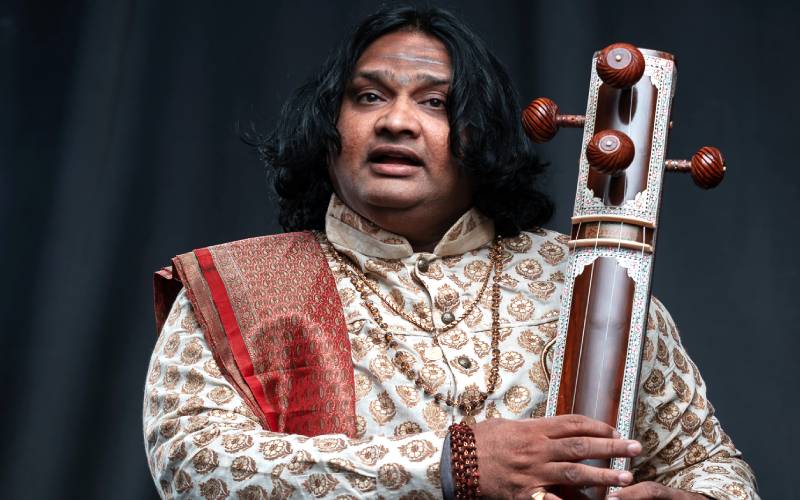
In today’s world of technology, there are few people who effectively use it for the greater cause of preserving the tradition and culture. Among these is Mahesh Vinayakram, one of the three sons of the renowned ghatam vidwaan, Padma Bhushan Vikku Vinayakram. He began to converse with the Verandah club, with a prayer, thanking Ishvara and the guru-parampara, which marked the stamp of an ardent Sanatana dharmi.
Mahesh Vinayakram is a leading vocalist and a percussionist, and his siblings, Selva Ganesh is a kanjira maestro, and Uma Shankar is a ghatam artist. The youngest of the three, Sangeetha, is a singer. The family serves the society musically by taking the swaraa-s to every nook and corner of the world, thus keeping up the lineage of the sangeetha-sampradhaaya.
The precursor of this musical household was none other than his grandfather, Brahmashri. T. R. Harihara Sharma, who was a celebrated mridhangam vidwaan. It is praiseworthy to note that the dheergha darshi never used to disappoint any person who approached him to learn mridhangam. He used to suggest appropriate musical instrument in which they may excel. Mahesh Vinayakram is one of the third-generation musicians and the tradition is being carried on even by his children, Gurupriya and Guruprasad.
It can be said that rhythm has been an integral composition of Mahesh Vinayakram, like the melodies hidden in the strings of veena. He is habituated to play any instrument that comes on his way. He said that konnakkol forms the grammar of percussive instruments, and when one learns it, he/she will be able to practically apply it even in mridhangam which is considered to be the king of percussion instruments . The musician also expressed that he had only learnt the art by listening to it repeatedly.
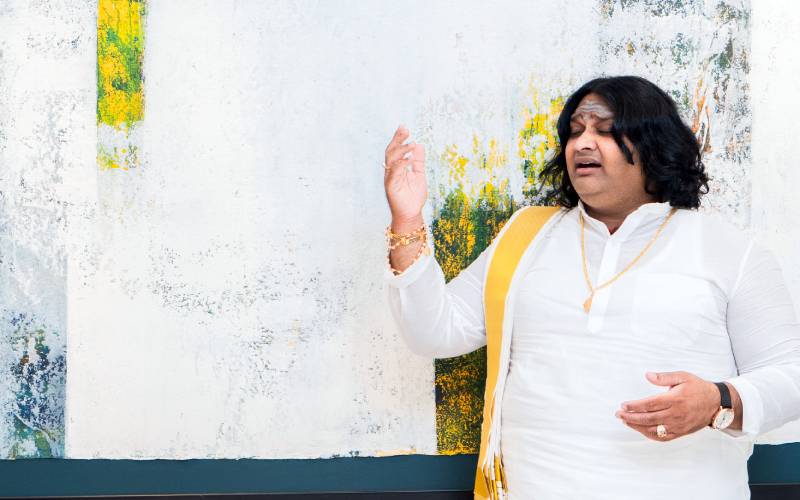
“I employ my father’s double-finger technique to play any percussive instrument and that has taken me this far,” said Vidwaan Mahesh. “Now, I play pandrum, which has its origin from hangdrum. It uses the same methodology of playing with variations. Pandrum is now widely known as handpan in Switzerland, zenko in France and sundrum in Czech Republic. I draw on the same Indian-percussive-instruments-handling technique on a wide range of instruments and I can play around 60 such variegates currently.”
Although pandrum is a European instrument, it is more likely to resemble a ghatam in its musical aspect. A source also claims that ghatam could have been an inspiration for the origin of pandrum as how pakhawaj gave rise to tabla. The resonance that the steel plates emitted was rightly made into a pan, and to make it highly musical, various swaraa-s were made a part of it.
“I have brought out my compositions using the hand pan in three musical albums. Even though my friends possessed pandrums, owing to its extremely fragile nature, it was not possible for it to be carried during a travel. So I had to proceed abroad to make two of my albums. I had used Tacta handpans from Brazil in my albums, and what I have is an European one.”
The possible origin of the handpan could be traced back to a village in Switzerland where a couple had begun making these. Later, in the course of time all European countries started manufacturing their own handpans. In India, a person named Takur in Goa arranges handpan gatherings with nearly 22 to 25 of them. One of the significant things to be noted is that unlike other instruments which produces banging sounds, handpan supplies to the ears, a meditative and a soothing music.
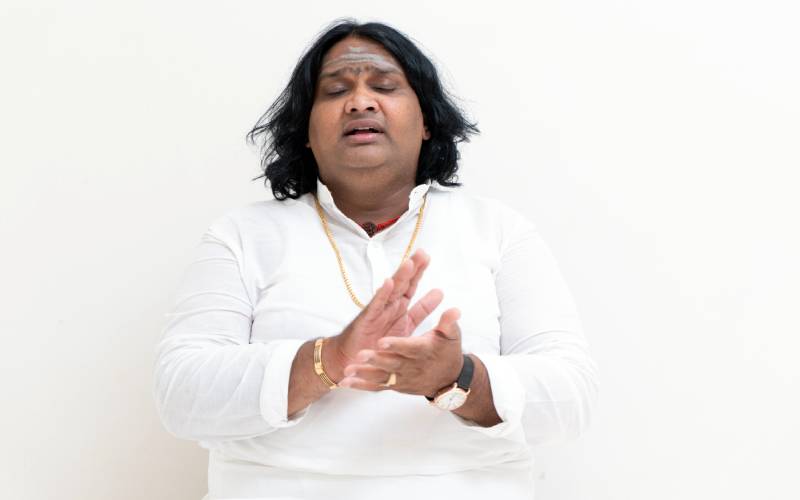
The cost involved in acquiring a handpan is too high, which is also a reason why many musicians do not go for it. The skin and the quality of the make also differs with the cost. It takes nearly four months for the product to be produced and one has to travel to the production place in order to collect it. Though it is an arduous process, if one can contemplate on the music that the handpan could produce, then even the labour involved is nullified.
“I was once traveling in Europe, Germany, near Frankfurt and had to head towards Porto in Portugal. I camped there for few days expecting few music concerts, and during the stay one of my friends advised me to travel to Lisbon where he was planning to arrange two or three concerts. He had also added that one of the instrument makers knows me and that I could stay along with him.”
“On reaching Lisbon, I found the host waiting for me. He is an instrument maker who does ghatams in a highly digitised way. I went along with him to his studio which displayed many instruments, and he guided me towards my room. In the room on the wall, I found there were three hangdrums hung. The moment I saw the hangdrums, I started to play them by simply tapping. The host had watched me playing for a while from outside the room, and he instantaneously entered and gave me a surprise.”
“He uttered that he was happy to see me playing the hangdrum and began narrating the story behind that instrument. He said that the hangdrum was made by an Italian maker and he had asked him to hand it over to the right person who truly deserves it. My host readily offered it to me treating me deserving. I got tears, and did not know how to give him a reply. That was a joyous moment when I did not sleep the whole night but was simply playing it.”
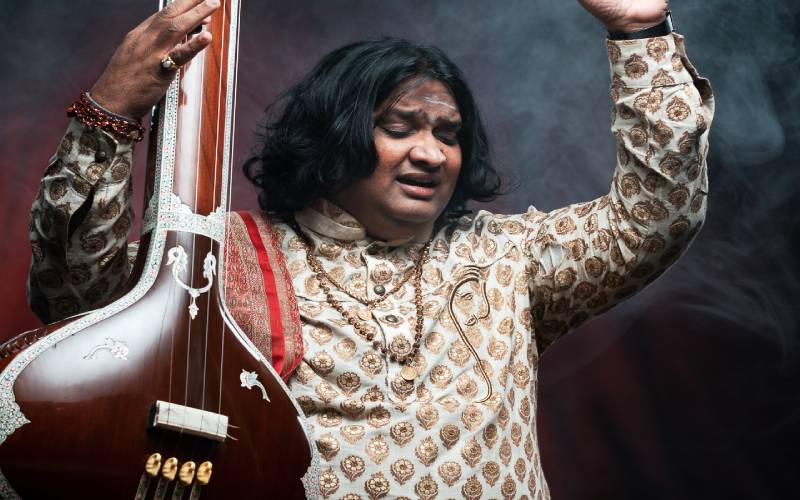
“The next day my host remarked that he did not have a case for it. So, I wrapped it in a blanket which was provided for me, and carried it in a shopping bag. I started my fro-journey by moving towards the airport. When I reached Frankfurt, I decided to buy a bag to carry the pandrum. On enquiring a music instrument shop which was well-known to my father, I came to know that the case priced more than the pandrum itself. So, I asked the shopkeeper for an alternative way and he suggested me to take a cymbal bag free of cost. This I would say was a true blessing.”
“There were many conditions to travel in foreign flights along with excess baggage, and cymbal bag was huge. I was just pondering on what to do next, and did not know how to proceed. I soon made my prayers to Kanchi Periyava and proceeded to procure my tickets. On that day, there was a thick crowd for the same flight in which I was about to travel. Fortunately, because of Periyava’s grace I got a seat in business class and also one separate seat for the instrument.”

The hangdrum artist correlated his experience to a similar one, of his father, Vikku Vinayakram, where his sincere prayers to Mahaperiyava had helped him. It is evident from the experiences of the artist that sincere prayers are always answered. Bhakthi and naadha are inseparable from each other and in fact complement each other. The person who uses naadha for the sake of the supreme is always successful and humble.
“I'm the first Indian to be casted in the French theatre, Cirque du Soleil. The theatre screens daily-shows in Las Vegas in London, America, and many other countries. They have many categories in film casting which includes touring shows, arena, continuous shows etc. I performed 320 shows in the 345 days schedule under the touring show category. I had to perform daily, except on Mondays. From Thursday till Sunday, I was occupied with double shows a day. Everyday I had to face 2500 pairs of eyes.”
“The program consisted of various parts. In the first part, I had to sing a portion of the Mariachi Opera, and in the second part, I revealed my Indian avatar. The idea of the director was to portray a Mariachi with an Indian soul. It all happened on a revolving stage. During my 320th show, which was my last rendition there, I had to perform a mel aalaappanai in a particular section which was an emotional sequence involving pain. I felt the bliss when I saw the reaction of the awestruck audience. They were filled with emotions, and that had made me also go emotional. That is one such moments which I can never forget in my life.”
The alignment of body, mind, and senses is the goal of yoga, which is equally applicable to any other art. One has to bring in this alignment to experience the fullness. After the alignment, the sound produced in the show helps the audience relate to a particular situation. Mahesh exclaimed even that to be the nature of naadha. He further added few scientific facts to explain the body-mind-sense alignment. He said that the left part of the brain deals completely with survival and other logical expressions, while the right hemisphere is closely associated with emotions.
He said that bhakthi arises in the right side and it is the right balance of both the hemispheres that contribute greatly towards the above explained alignment. Even this, he said is limited, and to go beyond this limitation one has to recognize the cosmic connect which is essentially spiritual. When one is able to establish that connection, his/her artistic perspective of life changes and will bring in a transformation in the inner engineering of a person.
The swara vidwaan mentioned about the importance of self-discipline, and surrendering, which he summarized using the word, bhakthi. He said that is one of the important aspects in life which he had learnt from his experiences. He also gave insights about the science behind various practices in Sanatana dharma. All these he says can be understood only with absolute bhakthi. And the medium that he uses to invoke that bhakthi is naadha.
It can be undoubtedly pointed that Mahesh Vinayakram is the first Indian to be featured in those types of theatrical music concerts abroad. His productions and compositions can be accessed in 18 countries at platforms like YouTube, iTunes, Spotify, Cdbaby.com etc. Mahesh has recently released an album and is glad to have reached the magic number, 101. He said that this was possible only because of the technological advancements and migration to the online mode. He firmly believes that the future lies in the world of internet and one has to embrace it to grow.
His profound words registered an important message, “Don’t be confined to thinking about the outcome. Instead become detached from the result and be ready to innovate. My father used to jovially narrate a story about a kaalana paithiyam. He is the one who constantly thinks about the quarter anna lost, even if he is bestowed a company worth fortunes. He had inculcated in us the idea of having a wider vision and thinking innovatively. I would say karma is not only action and reaction, but karma is the attachment that one holds towards any action and their result."
Transforming one’s anger and other negative tendencies into positive ones helps a person largely to face life’s challenges. This, indeed, has given Mahesh the capability to create an identity for himself in the world of music. He has taken on himself the task of bridging tradition and technology which will help the next generation.
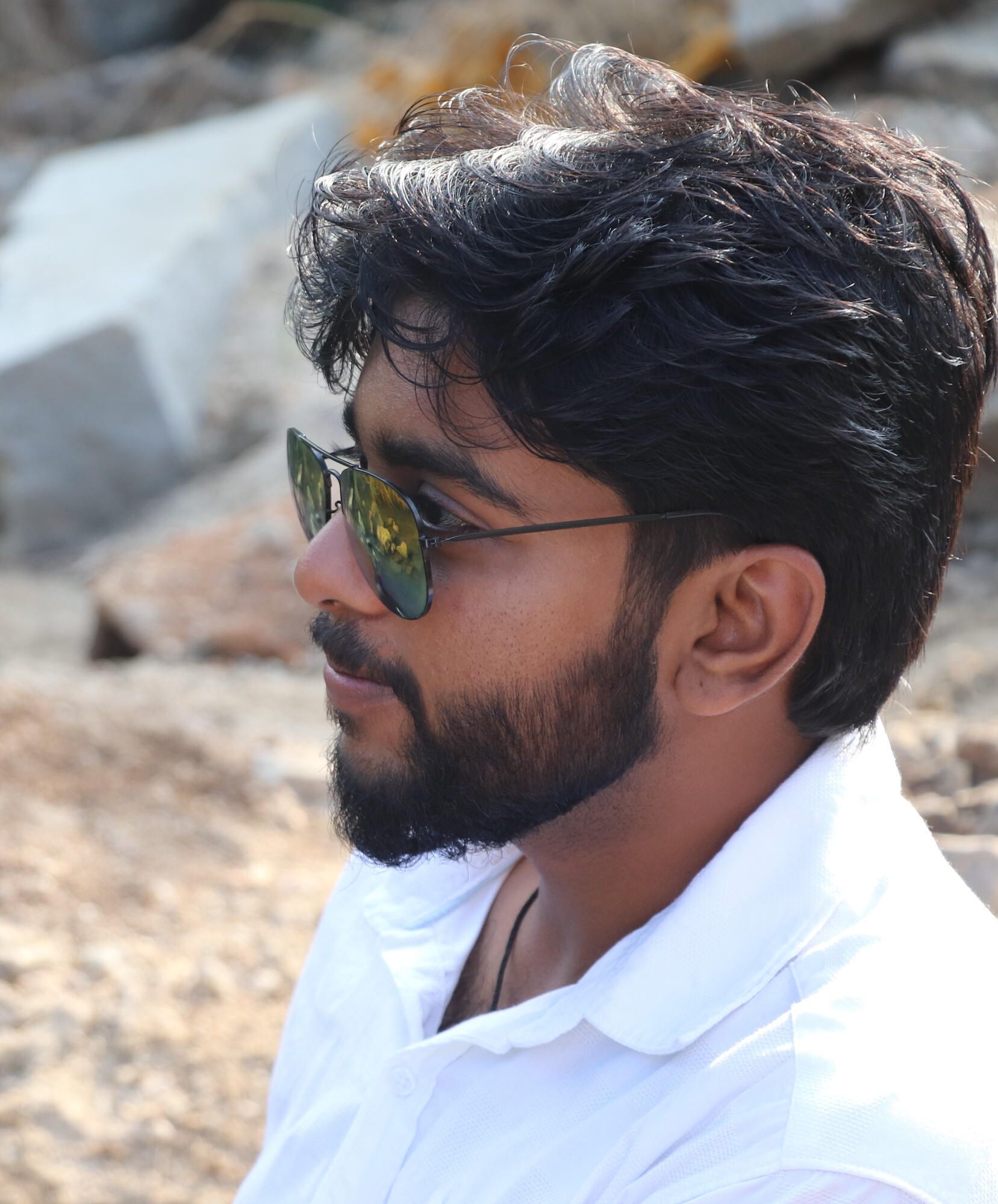 T. R. Surya is the special correspondent of the company. He is an eloquent speaker and compendious writer of English. An avid learner of Sanskrit and Indian scriptures under the guidance of Swami Ganeshaswarupananda and Gita Chaitanya of Arshavidyalaya. His inclination and interests are towards studying Metaphysics and philosophies.
T. R. Surya is the special correspondent of the company. He is an eloquent speaker and compendious writer of English. An avid learner of Sanskrit and Indian scriptures under the guidance of Swami Ganeshaswarupananda and Gita Chaitanya of Arshavidyalaya. His inclination and interests are towards studying Metaphysics and philosophies.
NEXT ARTICLE